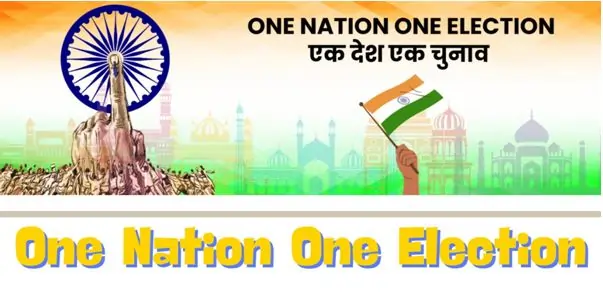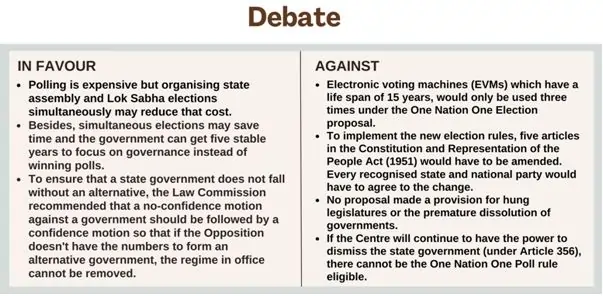
“One Nation, One Election” (ONOE) recently passed by the Government of India has attracted a lot of discussions all over India. This attempt has been proposed after consulting the report of a task force headed by the former President of India, Ram NathKovind and is intended to coordinate the Lok Sabha, State Legislative Assemblies, Municipalities, and Panchayats. For its supporters the change will increase administrative effectiveness and decrease costs of elections, whereas critics express more focuses on the impacts on Democracy and federalism.
The Case for ONOE
Those who are in support of ONOE’s gave the argument that the economic and administrative efficiency will definitely improve. While conducting polls for all the three tiers of elections at the same time would certainly common and avoid confusion. It would also reduce the annoying interferences of elections in governance, the stopping and starting process affording government’s opportunity for more policy formulation and planning.
Furthermore, those in favour have said that ONOE could result in a higher turnout of voters. Normally, the voters participate less because of several election and ONOE will bring a kind of sense of voting for in one go and encourage the voters to participate more. This potentially could enhance the democratic structure of the country by increasing public’s involvement.
Concerns and Criticisms
Still, there are many critics of the ONOE proposal. Critics have also discussed in detail threats posed to India’s federal structure is one of the concerns. Ideally every state in India has a different political, economic and social system. The synchronisation of state elections with the general nationwide elections pose a potential threat to the implementation of policies by state governments in regard to the specific state needs. Thus, the hegemony of the national-language political debates during the election campaigns can cover regionalist issues with political outputs, which creates centralization processes in political discourses.Further and more importantly, critics pointed out that the idea of holding frequent elections is too fundamental to democracy. Voting is the main way by which people exercise power over their leaders.
Constitutional and Real Life Challenges
State-wise application of ONOE would entail massive constitutional reforms concerning Articles 83, 85 — which provides for the duration of legislative assemblies — 172 and 356 — the last of which deals with the imposition of President’s Rule during the failure of constitutional machinery in the state. Such amendment requiresall party consensus which may not be easily possible in country due to different political climate.Also, the management of holding elections at the same time across the extensive and highly populated country becomes a great deal of work. Elections at state, district and parliamentary levels at single time would demand a lot efforts and efficient management.
The ‘One Nation, One Election’ model seems to paint a picture of a new structure for elections in India. As a supposed strategy with obvious economic and administrative potential, it poses major questions about democracy and federalism. While the debate rages on, it becomes imperative to factor in both, the opportunities and the risks, as and when electoral reforms are proposed and proceed in an effort to qualify the change that is sought not as a threat but as an opportunity to enhance instead of weaken the ‘Indianness’ of India’s democracy.
Advantages of One Nation One Election
The term ‘One Nation, One Election’ means holding parliamentary and state assembly polls simultaneously in India. The general intent of this proposal is to conduct elections at the same time across the nation. By doing this it helps in the following ways:
- Cost Efficiency: Elections in different constituencies of the Lok Sabha and all the state assemblies require a lot of money to be spent. There is a major possibility that through holding such elections at the same time, a lot of money from the taxpayers shall be saved. The spending that would have been used in catering for security, logistics, and administrative issues can be directed to more productive sectors of the economy such as the provision for education and health.
- Administrative Simplicity: The idea of co-cording one election cycle makes it easier than when there are several cycles. Traditionally, election commissions and state agencies can dedicate their energy, money and time to one major event rather than having to divide themselves through several election cycles. This helps avoid diluting of the energies which are channelled and the eventual voter list fatigue.
- Enhanced Voter Turnout: There is a possibility that voters are more likely to turn out to the polls in a sequential election. If the citizens are asked to vote for different representatives at the same time the levels of activity can be high because voters can feel the difference they make.
- Stability in Governance: Elections held most of the time can hinder efficient management of governance where the elected officials are most of the time preoccupied with their campaigns. One Nation, One Election plan is to say that elected representatives are likely to have a longer uninterrupted term in office so that they devote more time on policy formulation and development.
- Reduced Political Interference: There will be less frequency of election campaigns so there would be less scope for exercising the vote bank politics by political parties. This can help bring longer term policy making rather than short term vote gaining strategies.
- Uniformity in Political Landscape: These elections cause the political moment to be more aligned, getting voters to discuss national and state problem at the same time. This can assist in synchronising objectives of states with national goals and thus be of influential help in creating a much coordinated approach to governing.
Issues Connected with ‘One Nation One Election’
While the advantages are compelling, the implementation of One Nation, One Election faces several challenges:
- Constitutional Hurdles: The Constitution of India allows for separate elections for both general elections to the Lok Sabha and the Assemblies. The idea of implementing the simultaneous election can be done only if major changes can be made in the constitution, and as all know political controversies and legal disputes will always be a backlasher.
- Diverse Political Contexts: The level of politics, social and economic problems, and developmental needs in various states in India are not clearly the same. Election timing might not be enough to the group’s sentiments and this will down the purpose of democracy.
- Logistical Challenges: Generalizing elections, especially in a country as large as India, is not easy at all due to obvious organizational challenges. Synchronization would involve very careful planning to make sure that the foundation, security, and other facility to implement such a huge electoral process are all prepared adequately.
- Voter Education and Awareness: This implied that in the event that a government would need to embark on a transition to One Nation, One Election model, a serious voter educational programme would be very critical. The general populace needs to develop a better comprehension of the new electoral system, as well as its effects on decentralised government and representation.
- Political Resistance: The opposition might not support the simultaneous, believing that this might decrease their regional appeal or local campaign plan. Strong interests are likely to be encountered which is tied with preserving two electoral cycles.
- Impact on Local Issues: Holding elections together will deepen the reinforcement of local issues by national issues, which is likely to result in a standardization of political discussions at the national level. This could shift voters who are particularly concern with state issues.
Way forward
Addressing the challenges associated with One Nation, One Election requires a multifaceted strategy:
- Constitutional Amendments: It is appropriate to involve the professionals in law and constitutionalists to write such changes when the bicameral support is required. Large scale consultation with all political forces can lay the foundation to a process of change.
- Robust Voter Education Campaigns: Eliminating knowledge deficit among citizens, far reaching voter education campaigns can be undertaken. There is always a way of availing information on change to the masses by using technology, social media, and other subterranean movements.
- Focus on Local Representation: One way in which local issues can be protected during a synchronized process is by the local candidates and theireffective campaigns. People will be able to separate the local from the general election storyline, and focus on areas of most significance to them.
- Leverage Technology: Synchronous elections are not a big deal as they can be made easier using modern technology. Secure online voter registration, availability of secure technology for online voting, effective systems for storing data can improve the vote process.
- Address Political Concerns: Political partisanship is another major source of organizational resistance, and it can be prevented by involving the political parties in a discussion and addressing their concerns.
- Phased Implementation: There is need to phase out the One Nation, One Election as this can aids in sorting out a number of operational issues.

Conclusion
The notion of One Nation, One Election provides an interesting chance to change the electoral system of India. Thus, the benefits of cost efficiency, administrative convenient and enhanced governance cannot be dismissed while considering the drawback of this concept. However, the proposed amendments, the pilot approach, effective voters’ education, and use of technology are critical for the implementation of the strategy. Modernising and utilising these opportunities can go a long way in helping India lead the rest of the global democracy towards having a more coordinated process.